Vehicle Mounted Work Platform Tips Killing Bridge Inspector - Massachusetts
Case: 01-MA-041-01
Release Date: February 6, 2004
SUMMARY
On November 15, 2001, a 65-year-old male structural engineer (the victim) was fatally injured while inspecting a viaduct. The victim and another co-worker were conducting their inspection on a vehicle mounted work platform that was extended approximately 50 feet up and out in the passenger side direction when the truck tipped in that same direction. The ground below the extended work platform declined approximately 30 feet from the road level, and when the truck tipped, the platform fell approximately 80 feet striking a section of chain link fence. Representatives of a subcontractor, on site to set up the work zone, heard the truck tip and placed the call for emergency assistance. Personnel from the local police, fire department and the medical examiner’s office were notified and responded to the scene within minutes. The local medical examiner pronounced the victim dead at the incident site. The Massachusetts FACE Program concluded that to prevent similar occurrences in the future, employers should:
- ensure employees understand the importance of positioning vehicle mounted work platforms and proper deployment of outriggers prior to using the work platform
- develop, implement, and enforce a written comprehensive safety program, which includes vehicle mounted work platform safe operating procedures
- provide general and task specific safety training for all employees including contractors as outlined in their comprehensive safety program.
The Commonwealth of Massachusetts should:
- explore the possibility of revising contract bid applications to require that applicants submit a comprehensive safety program that addresses safe operating procedures and worker training for all tasks to be performed under the contract.
Manufacturers of vehicle mounted aerial work platforms should:
- explore the possibility of incorporating interlocks on all aerial lifts with outriggers that would prohibit operation if the outriggers were not fully extended.
In addition, companies that rent vehicle mounted aerial devices should:
- inspect the device, ensure a copy of the operator’s manual is with each device and provide training on the device prior to each rental.
INTRODUCTION
On November 15, 2001, the Massachusetts FACE Program was alerted by the local media, that on the same day, a 65-year-old male structural engineer was fatally injured when the extended vehicle mounted work platform he was working from tipped, causing him and another coworker to fall with the platform approximately 80 feet. An investigation was initiated and on December 12, 2001 the Massachusetts FACE Program Director and a co-worker traveled to the office location where the company’s president was interviewed. The police report, death certificate, corporate information, photographs of the incident site, and the Occupational Safety and Health Administration (OSHA) fatality/catastrophe report were reviewed during the course of the investigation.
The company, founded in 1965, was a civil engineering consulting firm and had offices throughout eastern New England, which included the corporate headquarters in Massachusetts. They employed approximately 140 people, four of these employees, including the victim, were part of the structural department.
The victim, an on-call project engineer contractor, was the company’s only senior structural engineer. He was a registered engineer with approximately 30 years of experience inspecting over 2,000 bridges. The victim and one other co-worker, who was also injured in the incident, but not fatally, were the only company representatives onsite. The co-worker was employed with the company as a fulltime junior structural engineer. The structural department had been established and integrated into the company approximately four years prior to the incident.
The company did not have a written health and safety program, although they did have some written safety materials, which consisted of temperature and weather-related safety topics for their field employees. Health and safety training had not been provided to employees, and there was no company safety committee. The company did state that they had provided the co-worker training through the truck rental company on how to properly operate a vehicle mounted work platform. Employees of the company, including the victim, were non-unionized.
INVESTIGATION
The company had been awarded a contract with the Commonwealth of Massachusetts for structural inspections of select viaducts for a major interstate. The company’s structural department was the group performing the viaduct inspection at the time of the incident.
On the day of the incident, the victim and the co-worker were scheduled to perform a structural inspection of a major interstate viaduct. This included, but was not limited to, inspecting the girders, girder connections, support posts, and looking for any overall possible loss of structural integrity. The viaduct inspection was scheduled to begin at approximately 10:30 p.m. to avoid peak motor vehicle traffic.
According to the company president, it was stated in the contract that the Commonwealth would supply the vehicle for the inspection task. In this case, the Commonwealth did not have a vehicle mounted work platform truck for the engineering consultant to use. Therefore, the consultant rented a 1994, six-cylinder diesel engine work platform truck that had 123,850 miles on the odometer. The truck had a flat deck body with a gross vehicle weight of 33,000 pounds. Attached to the flat deck was a hydraulic telescopic three-section 75-foot boom, four hydraulic outriggers, saddle boxes and a 5,400 pound hydraulic heel mounted winch. The mounted boom was also manufactured in 1994.
The incident site was located below a section of the major interstate viaduct, with travel lanes running north and south. The viaduct passed over a four-lane roadway that consisted of two lanes traveling east and two lanes traveling west (Figure 1). South of where the truck was parked was a sidewalk and a chain link fence. The land south of the chain link fence sloped approximately 30 feet down to a railway right of way (Figure 2).
At the time of the incident, the truck was parked in the southern most right-hand east bound lane of the four-lane roadway. A subcontractor onsite had set up a work zone using orange traffic cones. The work zone closed the right-hand east bound travel lane and merged motorists into the adjacent east bound travel lane around the work truck (Figure 3). The company stated that they were allowed to close only one travel lane during the viaduct inspection.
The truck was parked approximately 25 inches north of the curb. The sidewalk located to the south of the truck contained a cement barrier at the roadway edge that was approximately 19 inches high (Figure 3). This barrier made it impossible to fully extend the outrigger on the passenger side of the truck causing this outrigger’s articulating foot to be angled against the granite curbing and cement barrier. The barrier ended approximately 17 inches east of the spot where the passenger side outrigger articulating foot was located.
At the time of the incident, the victim was wearing his own, self supplied, personal body belt. His body belt was attached to a nine foot lanyard, which was tied-off to the work platform. The co-worker was wearing a harness supplied by the employer. In addition, the co-worker was using a nine foot lanyard, which was supplied by the victim, and tied-off to the work platform.
Approximately one hour into the viaduct inspection, the inspection switched from the west to the east side of the viaduct, which did not require moving the truck. This was the first time, during the inspection, that the work platform had been extended over the south side of the truck (passenger side), the side with the outrigger that was not fully extended. The work platform was extended approximately 50 feet at an angle of approximately 45 degrees. During the FACE investigation, the employer reported that while the work platform was extended out to this location, the victim and his co-worker felt as if the platform was sinking. The co-worker engaged the control and raised the work platform up. The workers felt the work platform sink again, and this time the work platform continued to accelerate. The platform descended to the ground with the workers, striking a section of chain link fence (Figure 4 and 5). The victim struck a metal fence post and was bounced out of the platform.
The subcontractor, on site to set up the work zone, heard the truck tip over and placed a call for emergency assistance. Personnel from local police and fire departments arrived on site within minutes. A call then was placed to the medical examiner’s office. The victim was pronounced dead at the incident site by a medial examiner. The co-worker was found conscious on the ground and reported back and ankle pain.
CAUSE OF DEATH
The medical examiner listed the cause of death as multiple traumatic injuries.
RECOMMENDATIONS/DISCUSSION
Recommendation #1:Employers should ensure employees understand the importance of positioning vehicle mounted work platforms and proper deployment of outriggers prior to using the work platform.
Discussion: The selected vehicle location for vehicle mounted work platforms prior to use should be free of obstacles and on level surfaces. Vehicles equipped with outriggers, as in this case, should always have their outriggers fully deployed and set on pads or solid surfaces to stabilize the vehicles during use of their work platforms. In addition, employers should ensure that employees understand the importance of proper vehicle positioning and usage of outriggers by providing employees standard operating procedures and training as discussed in the below recommendations.
Recommendation #2:Employers should develop, implement, and enforce a written comprehensive safety program, which includes vehicle mounted work platform safe operating procedures.
Discussion: A comprehensive safety program should consist of task specific written procedures and guidelines for employees to follow to ensure that they work safely. Topics that should be addressed for each specific task within the safe operating program should include, but not be limited to, hazard recognition, avoidance of unsafe conditions, and safety and health training. Employers, with employee input, should develop task specific safe operating procedures and guidelines with an emphasis on known hazards and proper equipment use.
Vehicle mounted work platform safe operating procedures should include, but not be limited to, pre-work inspection to ensure equipment is properly set up for use. The pre-work inspection could be formatted as a checklist and include questions about appropriate vehicles to be used to complete tasks, vehicle position, and extension of outriggers. During the pre-work inspection if a safety hazard is found, such as an outrigger not being fully extended, then the employees should evaluate the hazard and not begin the task until the hazard is eliminated. In addition, if a hazard is identified during the task process then the task should be stopped and the situation evaluated as outlined in the employer’s safe operating procedures.
In this case, the victim and the co-worker arrived at the work site, positioned the truck and extended the outriggers. The truck’s location prohibited the passenger side outrigger from being fully extended due to a 19-inch high cement barrier at the sidewalk edge. If the truck had been moved approximately 17 inches to the east past the end of the barrier, the outrigger would have had the space to be completely extended, reducing the possibility of the truck tipping during use.
Recommendation #3: Employers should provide general and task specific safety training for all employees including contractors as outlined in their comprehensive safety program.
Discussion: Employers should provide all employees general and task specific safety training, including how to safely operate equipment and complete tasks. The training should be outlined in the company’s comprehensive safety program and should be provided to new employees, including contractors, regardless of the employees’ previous experience and/or term of employment.
In this case, the victim, employed as a senior structural engineer on a contract basis, had over 30 years of experience. The employer did not provide him training on the proper use of the vehicle mounted work platforms. If employers do not provide training to senior and/or contract employees, there is the possibility that these employees might not be up to date with current safety and health regulations and newer and safer ways to complete tasks. Also, any unsafe work practices that may have been developed overtime could be passed unintentionally to coworkers.
Recommendation #4: Local and state government agencies should explore the possibility of revising contract bid applications to require that applicants submit a comprehensive safety program that addresses safe operating procedures and worker training for all tasks to be performed under the contract.
Discussion: The state agency, which contracted out the viaduct inspection, had an application to prequalify contractors for bid submission. This application for prequalification is valid for one year and asks about the applicant’s past work history and safety record for the past three years. Local and state government agencies should explore the possibility of adding into the contract bid application that each applicant is required to submit a written safety program as discussed in Recommendation #1. When safety is not a required part of a bid specification, contractors may risk losing jobs when they bid higher to account for costs of training, maintenance, and other safety elements.
Recommendation #5: Manufacturers should explore the possibility of incorporating interlocks on all aerial lifts with outriggers that would prohibit operation if the outriggers were not fully extended.
Discussion: In this case, one of the vehicle’s four outriggers had not been fully extended. The vehicle tipped approximately one hour into the inspection when the platform was extended for the first time over the side of the vehicle with the partially extended outrigger. Manufacturers should develop and install interlocks that would prohibit the work platform from being raised when all of the outriggers are not fully extended. If the operator attempted to raise the platform with one or more of the outriggers only partially extended, the interlock would be activated.
Recommendation #6: Companies that rent vehicle mounted aerial devices should, prior to each rental, inspect the device, ensure a copy of the operator’s manual is with the device and provide operator training on the device.
Discussion: All companies that rent out vehicle mounted aerial devices must ensure that the devices are safe to operate and that the lessors have been trained on the proper use and operation of the specific aerial device being rented. In addition, the rental company should perform a pre-rental inspection and ensure that copies of the operating and maintenance manuals are stored in a weather-resistant location on the aerial device.
REFERENCES
- Code of Federal Regulations, 29 CFR 1910.67, Vehicle-mounted elevating and rotating work platforms, Powered Platforms, Manlifts, and Vehicle-Mounted Work Platforms, Government Printing Office
- Code of Federal Regulations, 29 CFR 1910.132, General requirements, Personal Protective Equipment, Government Printing Office
- American National Standard / Manually Propelled Elevated Work Platforms / ANSI/SIA A92.2-1990. American National Standards Institute, New York, New York.
- NIOSH, 2001, Building safer highway work zones: measures to prevent worker injuries from vehicles and equipment. Center for Disease Control and Prevention, Publication No. 2001-128.
ILLUSTRATIONS
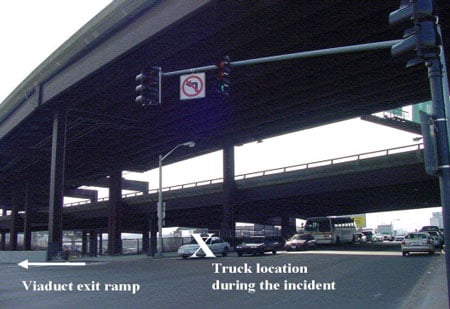 |
|
Figure 1 – Incident location: A interstate viaduct
|
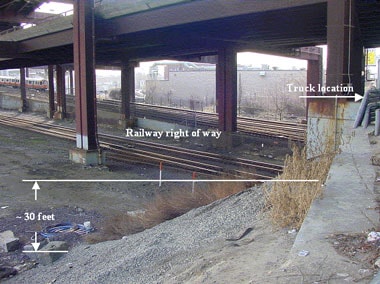 |
|
Figure 2 – Sloped land where work platform landed
Railway right of way |
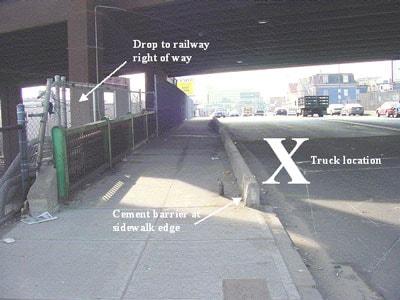 |
|
Figure 3 – Truck location
Sidewalk and cement barrier at edge |
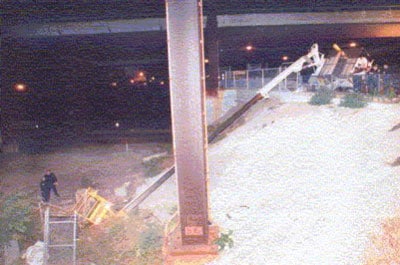 |
|
Figure 4 – Tipped truck with work platform against
the ground |
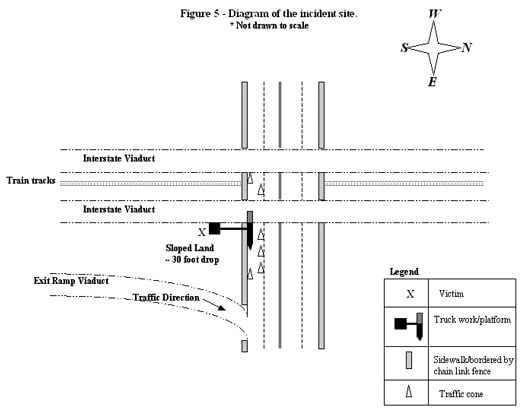 |
|
Figure 5 – Diagram of the incident site.
* Not drawn to scale |
To contact Massachusetts State FACE program personnel regarding State-based FACE reports, please use information listed on the Contact Sheet on the NIOSH FACE web site Please contact In-house FACE program personnel regarding In-house FACE reports and to gain assistance when State-FACE program personnel cannot be reached.
